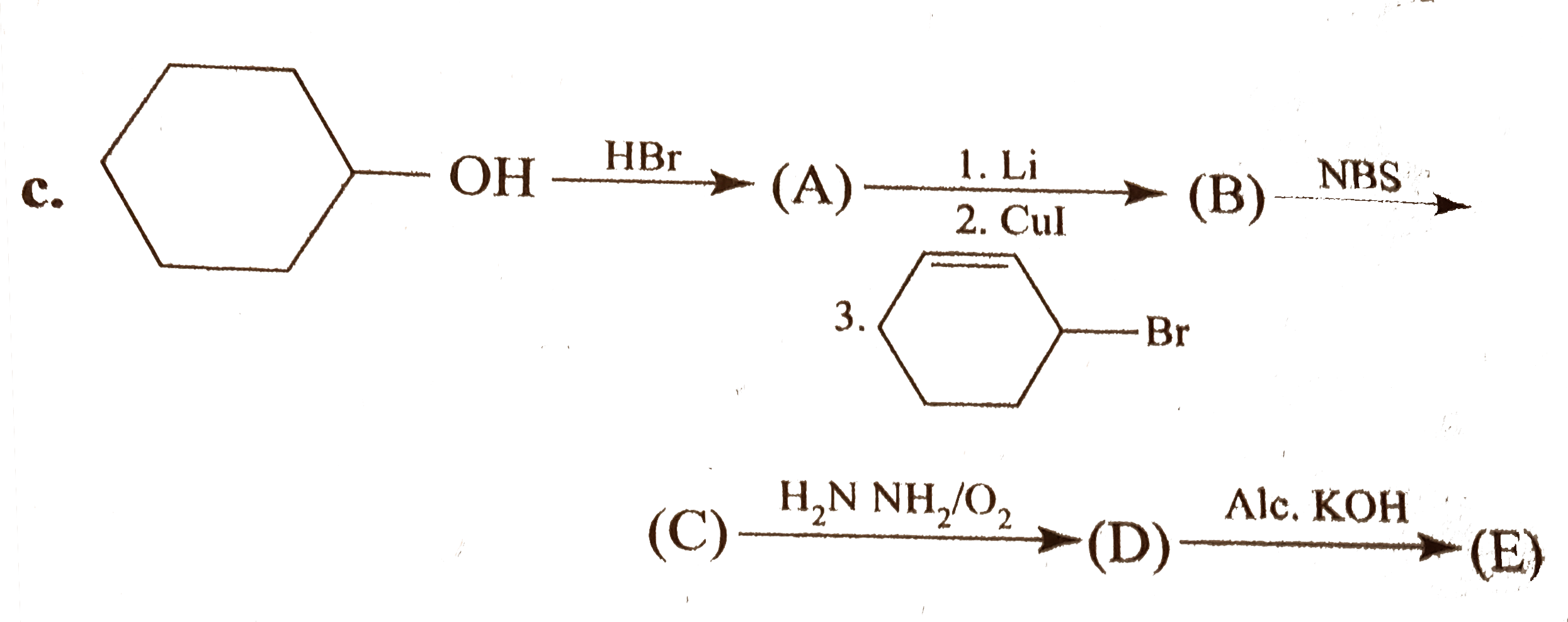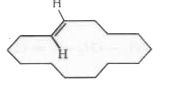F3C−CH=CH2HBr−−→(A)Nal−−−−−−−−−→dry.acetone(B)
F3C−CH(Br)−CH3andF3C−CH(I)−CH3
F3C−CH2−CH2BrandF3C−CH2−CH2I
BrF2C−CH=CH2andIF2C−CH=CH2
BrF2C−CH2−CH2BrandIF2C−CH2−CH2I
The correct Answer is:B
To solve the given question step by step, we will analyze the reactions of the compound F3C−CH=CH2 with HBr and then with NaI in dry acetone.
Step 1: Reaction of F3C−CH=CH2 with HBr
1. Identify the Reactants: We have an alkene F3C−CH=CH2 and HBr.
2. Markovnikov's Rule: According to Markovnikov's rule, when HBr adds to the alkene, the hydrogen atom (H) will attach to the carbon with more hydrogen atoms (the less substituted carbon), and the bromine (Br) will attach to the carbon with fewer hydrogen atoms (the more substituted carbon).
3. Addition of HBr:
- The double bond between CH and CH2 will break.
- The hydrogen from HBr will add to the CH2 carbon, and the bromine will add to the CH carbon.
4. Product A: The resulting product after this addition is:
A=F3C−CH(Br)−CH3
Step 2: Reaction of Product A with NaI in Dry Acetone
1. Identify the Reactants: The product A is F3C−CH(Br)−CH3 and it reacts with NaI in dry acetone.
2. Finkelstein Reaction: This is a nucleophilic substitution reaction where iodide ion (I−) from NaI will replace the bromine atom.
3. Better Leaving Group: Bromine is a better leaving group than fluorine, so the iodide ion will replace the bromine atom.
4. Product B: The resulting product after this substitution is:
B=F3C−CH(I)−CH3
Final Products
- Product A: F3C−CH(Br)−CH3
- Product B: F3C−CH(I)−CH3
Conclusion
After analyzing the reactions, we can conclude that:
- The correct answer for product A is F3C−CH(Br)−CH3.
- The correct answer for product B is F3C−CH(I)−CH3.
2. Markovnikov's Rule: According to Markovnikov's rule, when HBr adds to the alkene, the hydrogen atom (H) will attach to the carbon with more hydrogen atoms (the less substituted carbon), and the bromine (Br) will attach to the carbon with fewer hydrogen atoms (the more substituted carbon).
3. Addition of HBr:
- The double bond between CH and CH2 will break.
- The hydrogen from HBr will add to the CH2 carbon, and the bromine will add to the CH carbon.
4. Product A: The resulting product after this addition is:
A=F3C−CH(Br)−CH3
2. Finkelstein Reaction: This is a nucleophilic substitution reaction where iodide ion (I−) from NaI will replace the bromine atom.
3. Better Leaving Group: Bromine is a better leaving group than fluorine, so the iodide ion will replace the bromine atom.
4. Product B: The resulting product after this substitution is:
B=F3C−CH(I)−CH3
- Product B: F3C−CH(I)−CH3
- The correct answer for product A is F3C−CH(Br)−CH3.
- The correct answer for product B is F3C−CH(I)−CH3.
Topper's Solved these Questions
Similar Questions
Complete the following reactions :
a. (F)+D←−−(E)1.Li←−−−2.Cul(D)HBr←−−CH3CH=CH2NBS−−→(A)NBr−−−−→RCOOR(B)Mg−−→(C)
b. CH3CH=CH−CH32NBS−−−→(A)2Ic−−−→(B)H2NNH2/O2−−−−−−−−→(C)
c.
View SolutionConsider the following sequence of reaction and identify the final product (Z). CH3−CH=CH2HBr−−→(X)Aq.NaOH−−−−−→(Y)NaOH+l2−−−−−−→(Z)
View Solution
Knowledge Check
 Hbr−−→(X)Nal−−−→acetone(Y)(Major), Product (Y) is :Acis-2-buteneBtrans - 2- buteneC1-buteneDIso-butene
Hbr−−→(X)Nal−−−→acetone(Y)(Major), Product (Y) is :Acis-2-buteneBtrans - 2- buteneC1-buteneDIso-buteneBr−(CH2)12−C≡CHNaNH2−−−−→(A)Lindlar−−−−→Catalyst(B), Product (B) is
A B
B C
C DBr−(CH2)−CH=CH2
DBr−(CH2)−CH=CH2In the reaction ,
CH3−CH∣Br−CH3alc.KOH−−−−−→(A)HBr−−−−−−−→Peroxide(B)NaI−−−−−−→Acetone(C)
The compound (C) is :ACH3CH2CH2IBCH3CHICH2ICCH3CH2CH2CH2CH3DCH3CH2CHI2
Consider the following sequence of reaction and identify the final product (Z).
CH3−CH=CH2HBr−−→(P)aq.NaOH−−−−−→(Q)oxidation−−−−−−−−−−→K2Cr2O7/H+(R)
View SolutionComplete the following reactions
CH3CH=CH2mCPBA−−−−→AC2H5MgBr−−−−−−→H3O+B
View SolutionCH3CH2COOHCl2/Fe−−−−→(X)Alc.−−→KOH(Y)
Compound (Y) is :
View SolutionIn the following sequence of reactions,
CH3CH2CH2BrKOH(Alc)−−−−−−→ (A) HBr−−→ (B) KOH(aq)−−−−−→ (C ) The product (C) is
View SolutionCH3CH=CH2NBS−−→AKCN−−→BOH−/Δ−−−−−→CP/Br2−−−→DNH3−−→EΔ−−→F
View Solution
